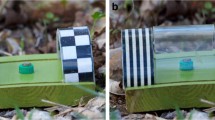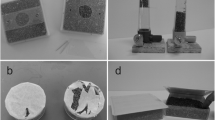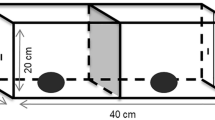Abstract
Birds can solve many cognitive tasks that were previously only solved by primates, implying that their cognitive ability is far greater than expected. Here, we investigated the ability of blue-fronted amazon parrots in solving the pebble-and-seed and the multi-access-box paradigms, two ecologically relevant cognitive tasks varying in complexity and required skills to solve. We also investigated whether laterality, sex and housing conditions influenced problem-solving capacity. We tested 14 adults kept in captivity and 27 reintroduced adults. Here, we present evidence of laterality for the species, showing right-footed, left-footed and ambidextrous individuals. Left-footed animals were more successful than the right-footed animals in the pebble-and-seed test. There was no sex difference in the problem-solving capacity of the blue-fronted amazon parrots for both pebble-and-seed and multi-access-box paradigms. Eleven captive animals were successful in at least one of the four multiple-access-box possible solutions. Four reintroduced individuals were successful in at least one of the multiple-access-box possible solutions. Only two captive animals and one reintroduced animal succeeded to solve more than one of the four multiple-access-box solutions. The average success rate of the pebble-and-seed test was 88.16% ex situ and 86.58% in situ, with individual variation in test-solving ability. Our study shows that unlike laterality, sex was not determinant in blue-fronted amazon parrots’ problem-solving ability. The blue-fronted amazon parrots have the visual discrimination skills needed for the pebble-and-seed task solution, and the motor skills for beak–foot coordination and potentially understanding of complex spatial relationships required for the string-pulling task, the multi-access-box solution achieved by most of the animals. Our results increased the knowledge of the cognitive ability of parrots, a group which lacked extensive cognition data.




Similar content being viewed by others
References
Altmann J (1974) Observational study of behavior: sampling methods. Behaviour 49:227–266
Auersperg AM, Gajdon GK, Huber L (2009) Kea (Nestor notabilis) consider spatial relationships between objects in the support problem. Biol Lett 5:455–458
Auersperg AM, Gajdon GK, Huber L (2010) Kea, Nestor notabilis, produce dynamic relationships between objects in a second-order tool use task. Anim Behav 80:783–789
Auersperg AM, Von Bayern AM, Gajdon GK et al (2011) Flexibility in problem solving and tool use of kea and New Caledonian crows in a multi access box paradigm. PLoS ONE 6:e20231
Benham WA (1906) Notes on the flesh-eating propensity of kea (Nestor notabilis). Trans R Soc N Z 39:71–89
Berenbaum SA, Korman K, Leveroni C (1995) Early hormones and sex differences in cognitive abilities. Learn Individ Differ 7:303–321
Berkunsky I (2010) Ecología reproductiva del Loro hablador (Amazona aestiva) en el Chaco Argentino. Thesis, Universidad Nacional de La Plata
Boire D, Nicolakakis N, Lefebvre L (2002) Tools and brains in birds. Behaviour 139:939–973
Buchanan K, Burt de Perera T, Carere C et al (2012) Guidelines for the treatment of animals in behavioural research and teaching. Anim Behav 83:301–309
Cauchoix M, Hermer E, Chaine AS, Morand-Ferron J (2017) Cognition in the field: comparison of reversal learning performance in captive and wild passerines. Sci Rep 7:12945
Cazakoff BN, Johnson KJ, Howland JG (2010) Converging effects of acute stress on spatial and recognition memory in rodents: a review of recent behavioural and pharmacological findings. Prog Neuropsychopharmacol Biol Psychiatry 34:733–741
Delius J, Güntürkün O, Kesch S (1988) Absence of footedness in domestic pigeons. Anim Behav 36:602–604
Ducker G, Luscher C, Schultz P (1986) carduelis) bei ‘manipulativen’ aufgaben. Zool Beitr 29:377–412
Emery NJ (2004) Are corvids ‘feathered apes’? In: Watanabe S (ed) Comparative analysis of minds. Keio University Press, Tokyo, pp 181–213
Emery NJ (2006) Cognitive ornithology: the evolution of avian intelligence. Philos Trans Royal Soc B 361:23–43
Forshaw JM, Cooper WT (1989) Parrots of the world. Blandford, London
Friedmann H, Davis M (1938) “Left-handedness” in parrots. Auk 55:478–480
Gray JA, Buffery AW (1971) Sex differences in emotional and cognitive behaviour in mammals including man: Adaptive and neural bases. Acta Psychol 35:89–111
Guigueno MF, MacDougall-Shackleton SA, Sherry DF (2015) Sex differences in spatial memory in brown-headed cowbirds: males outperform females on a touchscreen task. PLoS ONE 10:e0128302
Gutiérrez-Ibáñez C, Iwaniuk AN, Wylie DR (2018) Parrots have evolved a primate-like telencephalic–midbrain–cerebellar circuit. Sci Rep 8:9960
Hopkins WD (1999) On the other hand: statistical issues in the assessment and interpretation of hand preference data in nonhuman primates. Int J Primatol 20:851–866
Hyde JS (2016) Sex and cognition: gender and cognitive functions. Curr Opin Neurobiol 38:53–56
Iwaniuk AN, Dean KM, Nelson JE (2005) Interspecific allometry of the brain and brain regions in parrots (Psittaciformes): comparisons with other birds and primates. Brain Behav Evol 65:40–59
Jelbert SA, Taylor AH, Cheke LG et al (2014) Using the Aesop’s fable paradigm to investigate causal understanding of water displacement by New Caledonian crows. PLoS ONE 9:e92895
Jones CM, Healy SD (2006) Differences in cue use and spatial memory in men and women. Proc R Soc Lond (Biol) 273:2241–2247
Krasheninnikova A (2013) Patterned-string tasks: Relation between fine motor skills and visual-spatial abilities in parrots. PLoS ONE 8(12):e85499
Krasheninnikova A, Berardi R, Lind MA, O’Neill L, von Bayern AM (2019) Primate cognition test battery in parrots. Behaviour 156:721–761
Lattin CR, Pechenenko AV, Carson RE (2017) Experimentally reducing corticosterone mitigates rapid captivity effects on behavior, but not body composition, in a wild bird. Horm Behav 89:121–129
Lopes AR, Rocha MS, Junior MG et al (2017) The influence of anti-predator training, personality and sex in the behavior, dispersion and survival rates of translocated captive-raised parrots. Global Ecol Conserv 11:146–157
Magat M, Brown C (2009) Laterality enhances cognition in Australian parrots. Proc R Soc Lond (Biol) 276:4155–4162
Mendonça-Furtado O, Ottoni EB (2008) Learning generalization in problem solving by a blue-fronted parrot (Amazona aestiva). Anim Cogn 11:719–725
Olkowicz S, Kocourek M, Lučan RK et al (2016) Birds have primate-like numbers of neurons in the forebrain. Proc Natl Acad Sci USA 113:7255–7260
Ottoni EB, Izar P (2008) Capuchin monkey tool use: Overview and implications. Evol Anthropol Issues News Rev 17:171–178
Pepperberg IM (1999) The Alex Studies: cognitive and communicative abilities of grey parrots. Harvard University Press, Cambridge
Rogers LJ (1981) Environmental influences on brain lateralization. Behav Brain Sci 4:35–36
Rogers LJ (2000) Evolution of hemispheric specialization: advantages and disadvantages. Brain Lang 73:236–253
Rogers LJ (2008) Development and function of lateralization in the avian brain. Brain Res Bull 76:23–244
Rogers LJ, Workman L (1993) Footedness in birds. Anim Behav 45:409–411
Rogers LJ, Zucca P, Vallortigara G (2004) Advantages of having a lateralized brain. Proc R Soc Lond (Biol) 271:S420–S422
Sayol F, Lefebvre L, Sol D (2016) Relative brain size and its relation with the associative pallium in birds. Brain Behav Evol 87:69–77
Schuck-Paim C, Borsari A, Ottoni EB (2009) Means to an end: Neotropical parrots manage to pull strings to meet their goals. Anim Cogn 12:287–301
Sherwin BB (2003) Estrogen and cognitive functioning in women. Endocr Rev 24:133–151
Thorpe WH (1956) Learning and instinct in animals. Harvard University Press, Cambridge
Upadhayay N, Guragain S (2014) Comparison of cognitive functions between male and female medical students: a pilot study. J Clin Diagn Res 8: BC12–BC15.
Vince MA (1964) Use of the feet in feeding by the great tit parus major. Ibis 106:508–529
Whitt E, Douglas M, Osthaus B, Hocking I (2009) catus) do not show causal understanding in a string-pulling task. Anim Cogn 12:739–743
Wirthlin M, Lima NC, Guedes RL et al (2018) Parrot genomes and the evolution of heightened longevity and cognition. Cur Biol 28:4001–4008
Zaidi ZF (2010) Gender differences in human brain: a review. Open Anat J 2:37–55
Acknowledgements
We thank all staff at CETAS-TANGARA PE for logistical support during data collection. We also thank Professors Artur Maia, Rachel Lira and Wallace Junior for fruitful discussions and comments on an earlier version of this manuscript. We thank Rebecca Umeed for grammar revision, Karolina Medeiros for technical support (FACEPE—BFT01602.04/17) and Mr Benedicto Alves Godinho for helping to build up the multi-access-box. Lucas Godinho was funded by a scholarship from The Brazilian National Council for Scientific and Technological Development—CNPq (147010/2016–0). We thank the Coordination for the Improvement of Higher Education Personnel (CAPES) and the Programa de Pós-Graduação em Biologia Animal of the Universidade Federal de Pernambuco for further logistical support.
Author information
Authors and Affiliations
Corresponding author
Ethics declarations
All observations and experimentation conducted in this study was non-invasive and followed the ethical rules of animal treatment in behavioural research and teaching (Buchanan et al. 2012). The research presented here adheres to the Brazilian legislation (Law 11,794 of October 8, 2008, Decree 6899 of July 15, 2009) and to the norms issued by the National Council of Control of Animal Experimentation (CONCEA), having been approved by the Ethics Committee of Animal Use (CEUA) of the Federal University of Pernambuco (UFPE) (Process number 23076.006233/2017–94). The research was also approved by the managers of the Tangara Wildlife Rescue Centre in Pernambuco (CETAS-Tangara PE), an organisation belonging to the State Agency of the Environment of the State of Pernambuco (CPRH).
Additional information
Publisher's Note
Springer Nature remains neutral with regard to jurisdictional claims in published maps and institutional affiliations.
Electronic supplementary material
Below is the link to the electronic supplementary material.
Supplementary file5 (MP4 15314 kb)
Supplementary file6 (MP4 33296 kb)
Supplementary file7 (MOV 36951 kb)
Supplementary file8 (MP4 27132 kb)
Supplementary file9 (MOV 51525 kb)
Rights and permissions
About this article
Cite this article
Godinho, L., Marinho, Y. & Bezerra, B. Performance of blue-fronted amazon parrots (Amazona aestiva) when solving the pebbles-and-seeds and multi-access-box paradigms: ex situ and in situ experiments. Anim Cogn 23, 455–464 (2020). https://doi.org/10.1007/s10071-020-01347-6
Received:
Revised:
Accepted:
Published:
Issue Date:
DOI: https://doi.org/10.1007/s10071-020-01347-6




